Health
Fauci says West Nile Virus was a ‘harrowing’ experience: ‘Afraid I would never recover’
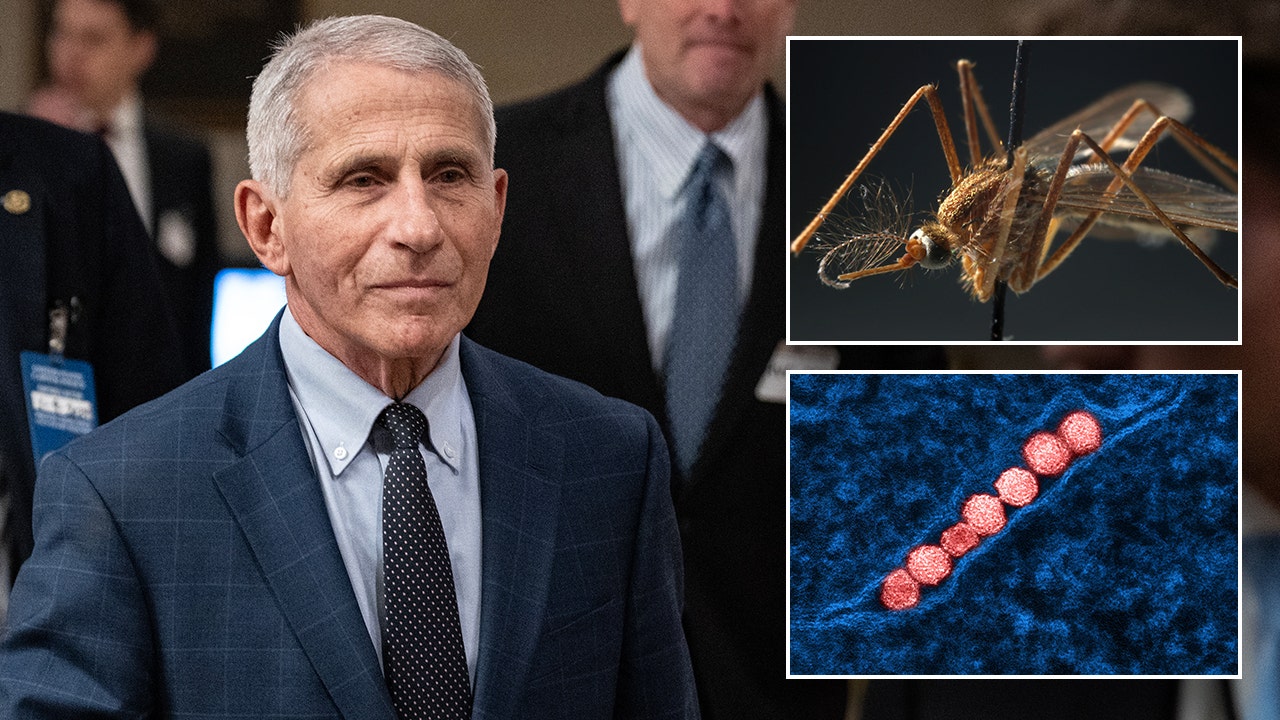
Dr. Anthony Fauci, the public face of the U.S. coronavirus pandemic response, is speaking out about his “terrifying” bout with West Nile virus (WNV) in August.
In an op-ed in The New York Times on Monday, the former top infectious-disease official, now 83, wrote that he believes he caught the virus from a mosquito bite while outdoors at his Washington home.
He chalked up his weakness and fatigue to lingering COVID symptoms at first, until he “became delirious and incoherent with a temperature of 103 degrees,” leading to a six-day hospitalization.
ANTHONY FAUCI’S WEST NILE VIRUS DIAGNOSIS: WHAT TO KNOW ABOUT THE MOSQUITO-BORNE DISEASE
“After I spent more than 50 years chasing and fighting viruses, one fought back and nearly took me down,” Fauci wrote.
Former NIAID Director Dr. Anthony Fauci was hospitalized in August with the West Nile virus. (Drew Angerer/Getty Images, main, E. Jason Wambsgans/Chicago Tribune/Tribune News Service via Getty Images, top right, NIH-NIAID/IMAGE POINT FR/BSIP/Universal Images Group via Getty Images, bottom right.)
“There is no treatment for West Nile virus disease, and I was left to deal with its toll on my body.”
He described the experience as “terrifying” and “harrowing.”
“A very scary part of the ordeal was the effect on my cognition,” Fauci said.
WEST NILE DEATH REPORTED IN TEXAS AS HEALTH OFFICIALS WARN RESIDENTS TO SAFEGUARD AGAINST MOSQUITOES
“I was disoriented, unable to remember certain words, asking questions of my family that I should have known answers to.”
“I was afraid that I would never recover and return to normal.”
Fauci has since recovered, stating that the cognitive symptoms have subsided and he is now walking several miles each day.
“I was afraid that I would never recover and return to normal.”
“I tell my story because West Nile virus is a disease that, for many people, can have devastating and permanent consequences,” he wrote.
In the op-ed, Fauci called for more resources to address the threat of West Nile, which can have “devastating and permanent consequences.”
What to know about West Nile virus
As of Oct. 8, there have been 976 West Nile virus cases in the U.S. across 46 states, according to the Centers for Disease Control and Prevention (CDC).
Among those, 684 cases were neuroinvasive (severe).
Since the West Nile virus first entered the U.S. in 1999, it has become the leading cause of mosquito-borne disease in the country.
IN A POTENTIAL OUTBREAK, IS BIRD FLU TESTING AVAILABLE FOR HUMANS? WHAT TO KNOW
In most cases, the West Nile virus — a flavivirus in the same family as yellow fever, dengue fever, Japanese encephalitis and the Zika virus — is spread when Culex mosquitoes bite infected birds and then bite people and other animals, per the CDC’s website.

“I tell my story because West Nile virus is a disease that, for many people, can have devastating and permanent consequences,” Fauci wrote. (CBS)
The virus is not transmitted through eating or handling infected animals or birds — nor is it spread through physical contact, coughing or sneezing.
A vast majority — around 80% — of the people who contract the virus will not experience any symptoms, the CDC states on its website.
IN A POTENTIAL OUTBREAK, IS BIRD FLU TESTING AVAILABLE FOR HUMANS? WHAT TO KNOW
“It causes a rash and other symptoms, including swollen lymph nodes, which other viruses in its class do not exhibit,” Dr. Marc Siegel, senior medical analyst for Fox News and clinical professor of medicine at NYU Langone Medical Center, previously told Fox News Digital.
“It only affects the nervous system 1% of the time and is rarely fatal.”
Around one in five people will develop febrile illness, which is marked by a fever along with body aches, headache, joint pain, diarrhea, rash and/or vomiting.
The virus only affects the nervous system 1% of the time and is rarely fatal.
These symptoms usually go away on their own, but some people may have lingering weakness and fatigue months after infection.
In rare cases — about one in every 150 infected people — the virus can lead to serious conditions affecting the nervous system, such as encephalitis (inflammation of the brain) or meningitis (inflammation of the membranes that surround the brain and spinal cord), the CDC states on its website.
Those who develop serious illness may experience headache, stiff neck, high fever, disorientation, vision loss, muscle weakness, convulsions, tremors, coma or paralysis, which occur when there is viral infection of the central nervous system.
Among people who have this invasive form of the illness, around 10% will die.
It affects the nervous system 1% of the time and is rarely fatal, statistics show.

Since the West Nile virus first entered the U.S. in 1999, it has become the leading cause of mosquito-borne disease in the country. (iStock)
While anyone can potentially develop severe illness, the highest-risk groups include those over 60 years of age, people who have had organ transplants and those with diabetes, cancer, high blood pressure, kidney disease, immune disorders and other certain medical conditions.
“The virus’ effects can be quite serious in the elderly,” Siegel noted.
Diagnosis and treatment
Those who think they might have been infected with WNV should be assessed by a health care provider, the CDC states.
Diagnosis of the infection can be made based on evaluation of symptoms, recent exposure to mosquitoes and testing of blood or spinal fluid.
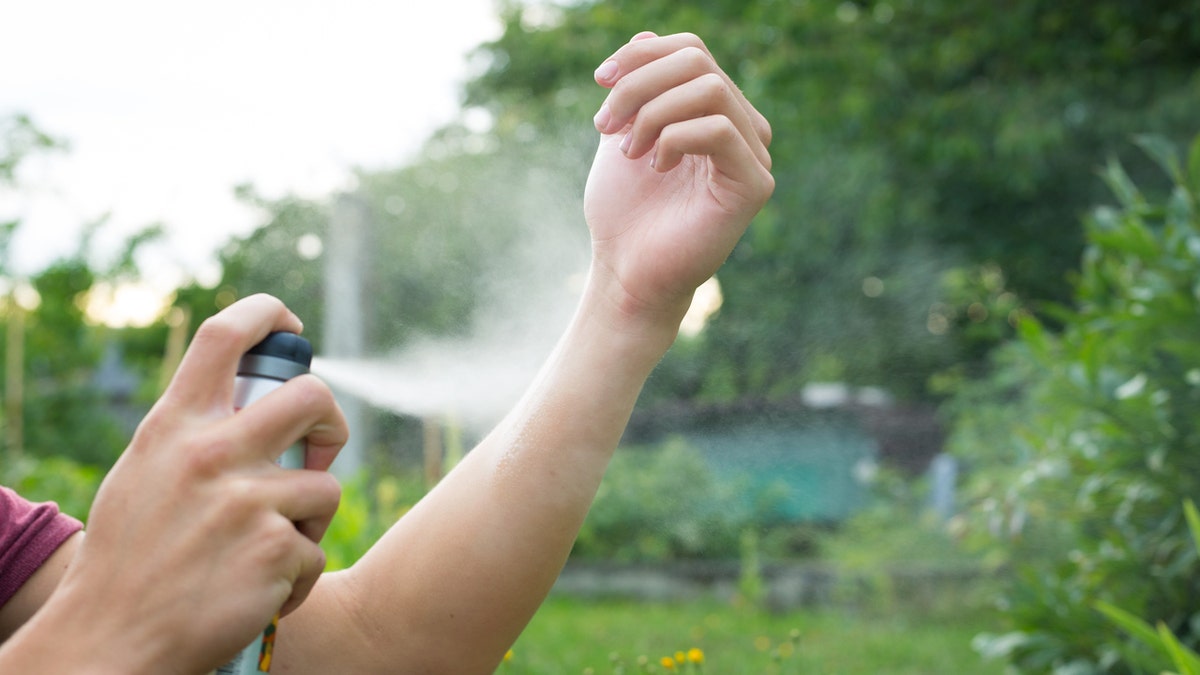
The most effective means of prevention is to protect against mosquito bites by using insect repellent, wearing long-sleeved shirts and pants, and taking steps to control exposure to mosquitoes. (iStock)
Health care providers will typically recommend treating symptoms with over-the-counter pain medications and getting plenty of rest and fluids.
Those who experience severe illness may need to be hospitalized for supportive care.
Preventing the virus
There is currently no vaccine for West Nile virus.
“The virus can be contained through public health measures including more insect repellent with DEET, longer sleeves and less stagnant water in our backyards,” Siegel said.
CLICK HERE TO SIGN UP FOR OUR HEALTH NEWSLETTER
Trying to kill adult mosquitoes by spreading too much insecticide can be problematic, the doctor warned.
“Animals, people with asthma and insects that would otherwise kill the mosquitoes are affected.”
The most effective means of prevention is to protect against mosquito bites, the CDC confirmed.
For more Health articles, visit www.foxnews/health
The agency’s recommendations include using insect repellent, wearing long-sleeved shirts and pants, and taking steps to control exposure to mosquitoes — particularly at dawn and dusk.
Eliminating any standing water outdoors can help prevent mosquitoes from breeding.

Health
Woman with muscular dystrophy completes 12 marathons in wheelchair for charity: ‘Won’t let it define me’
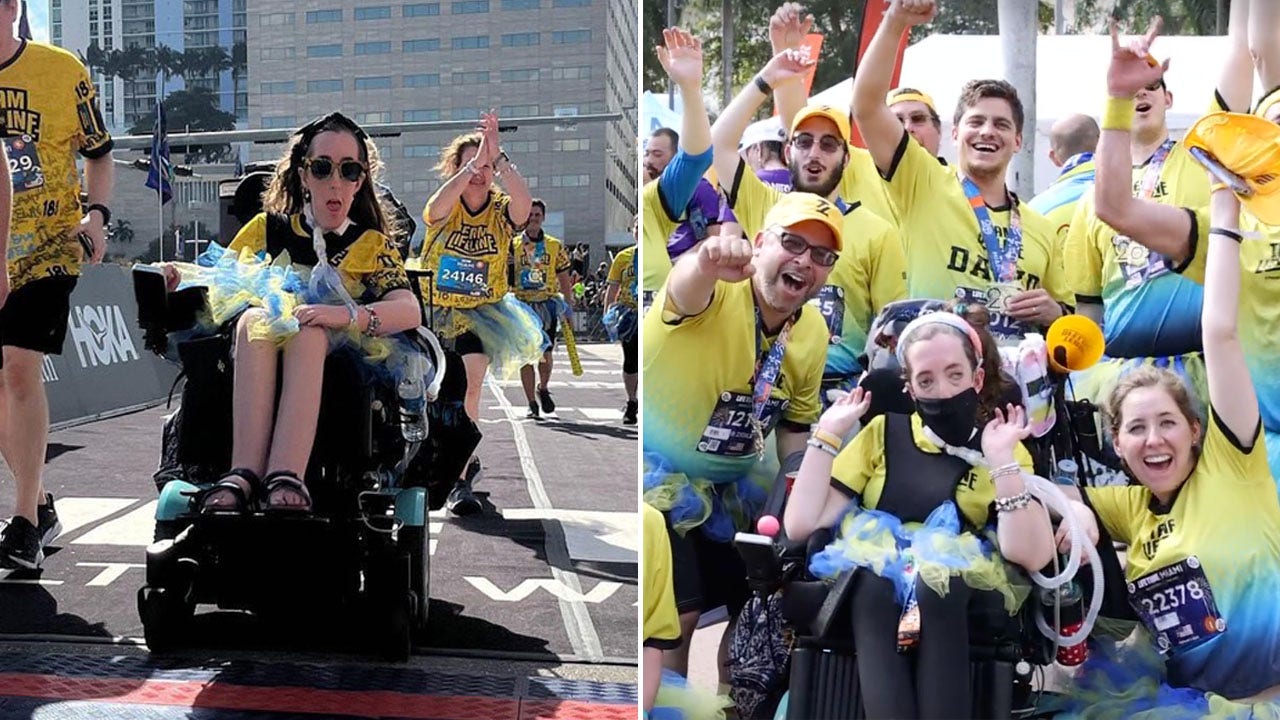
Born with a rare form of muscular dystrophy, Peri Finkelstein has never let her disorder define her.
Instead, the 24-year-old New Yorker has used her challenges as a springboard to make the world a better place, completing 12 marathons to raise funds for charity.
In January 2024, Finkelstein’s nonprofit organization — the Team Peri Foundation — exceeded the $1 million fundraising milestone for its Chai Lifeline project, which offers support to families following an illness diagnosis or trauma.
FATHER CREATED A DRUG TO SAVE HIS SON FROM A RARE DISEASE, NOW OTHER FAMILIES ARE DESPERATE TO GET IT
Making an impact
Muscular dystrophy is a group of more than 30 genetic conditions that affect the functioning of the muscles, according to Cleveland Clinic.
Peri Finkelstein, 24, has raised more than $1 million to help children with deadly diseases, partly through her marathon events. (Team Peri Foundation)
Finkelstein’s form of the condition, called nemaline rod myopathy, causes severe muscle weakness and affects her speech and mobility.
Despite her physical limitations, she was inspired to start doing marathons in 2010 when her mother and brother began running them for charity.
“After watching everybody do the marathon and cheering from the sidelines, I knew that I wanted to make more of an impact,” she said during an interview with Fox News Digital.
MOTHER FRANTIC TO SAVE CLINICAL TRIAL THAT COULD CURE HER DAUGHTER: ‘THE TREATMENT IS SITTING IN A FRIDGE’
For the first few years, Finkelstein’s mother pushed her in a jogging stroller with all the necessary medical equipment secured to the bottom.
Then, in 2016, Finkelstein decided it was time to stand up and walk a few steps over the finish line, with the help of her physical therapist and her parents.
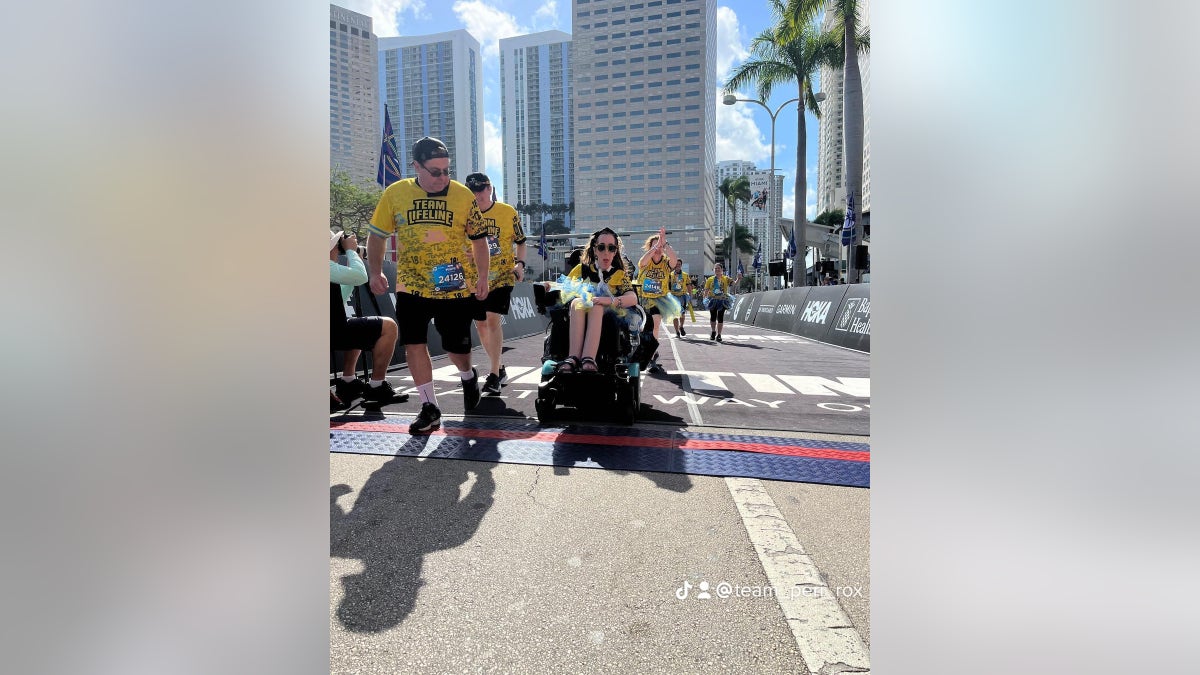
Finkelstein heads toward the finish line of a marathon in Miami, Florida, in February 2024. (Team Peri Foundation)
“At that moment, it felt as if I could do anything that I put my mind to,” she said.
“It was a defining moment, when I realized the only person who could get in my way was myself — and that it was up to me to change my life.”
‘LIQUID GOLD’ COULD BRING NEW HOPE TO MULTIPLE SCLEROSIS PATIENTS, STUDY SUGGESTS: ‘PROFOUND BENEFIT’
In subsequent marathons, those initial steps turned into walking more than 1,000 steps, then a mile, and then a mile and a half, forwards and backwards across the finish line.
After several years of pushing that “extra mile,” Finkelstein experienced medical challenges in 2022 that made her unable to compete.
“It never dawned on me that part of my life would be over,” she said.
“You have to push yourself to the limit for each mile marker, as nothing will ever come easily.”
“Once I officially lost that part of myself, I realized that I couldn’t allow this setback to get to me — I knew that I had to keep moving.”
Instead of competing physically, Finkelstein now funnels her energy into her foundation’s fundraising efforts.

Finkelstein’s form of muscular dystrophy, nemaline rod myopathy, causes severe muscle weakness and affects her speech and mobility. “Not every day is all rainbows and sunshine,” she said. (Claudio Papapietro)
“Since I was 8 years old, my dream was to launch a nonprofit organization of my own,” she said.
“The same mindset that I used to prepare both physically and mentally for a marathon is what I carry into my daily life as an entrepreneur.”
STIFF PERSON SYNDROME PATIENTS SHARE WHAT IT’S LIKE TO LIVE WITH THE RARE DISEASE
The Team Peri Foundation strives to make the world a “more connected and inclusive place for all,” Finkelstein said, with the mission to “educate others on the power of inclusion and to disrupt the stereotypical views revolving around disability.”
‘Not all rainbows and sunshine’
While Finkelstein strives to stay positive and focus on her goals, she acknowledges that her day-to-day life isn’t always easy.
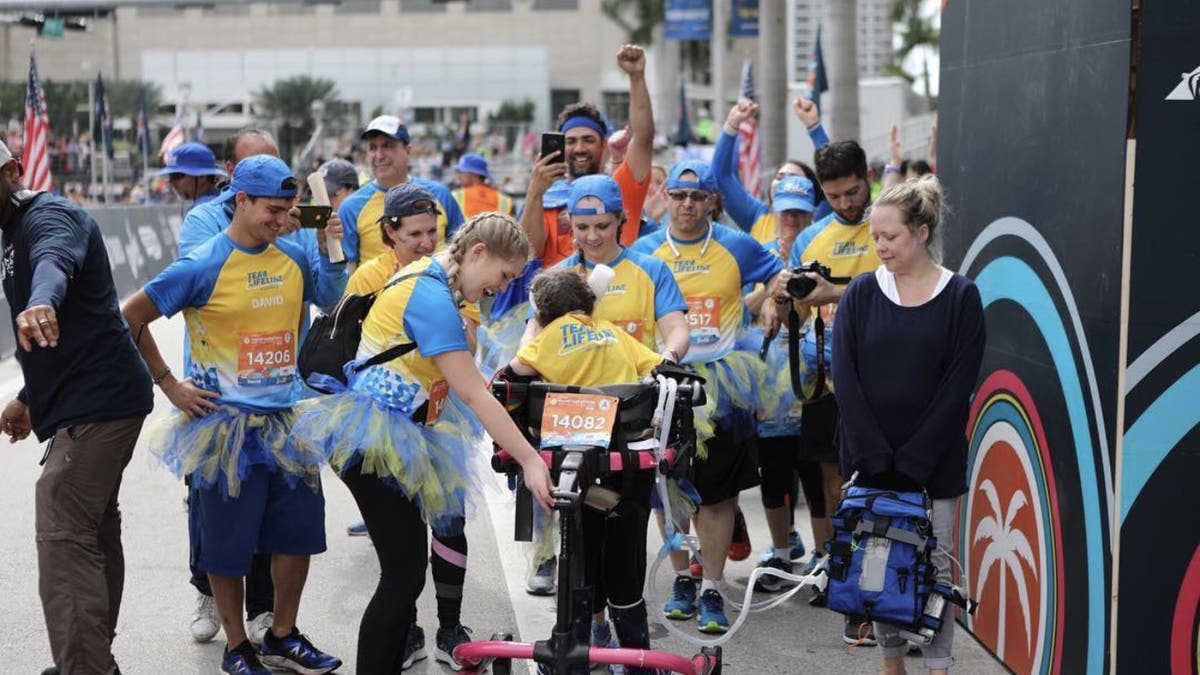
Finkelstein’s family and friends support her during a marathon in Miami. (Team Peri Foundation)
“Not every day is all rainbows and sunshine — some days are harder than others, to the point where severe migraines, fatigue and pain keep me from doing what I have to do,” she said.
THE GIRL WHO CAN’T SMILE: HOW A RARE DISORDER BECAME A YOUNG WOMAN’S ‘GREATEST GIFT’
Finkelstein undergoes different forms of therapy multiple times a week, has frequent doctor’s appointments and is “always in pain,” she shared.
Her social media posts highlight the highs and lows.

Finkelstein is pictured with her parents, Paul and Lori Finkelstein, on the day her foundation hit the $1 million fundraising mark in January 2024. (Team Peri Foundation)
“My hope is that by sharing bits and pieces of my world — portraying all the different sides of me, whether it’s rather dark or filled with light — I can portray that people with disabilities can live a full life and step out of line in ways that can change the course of their future,” she said.
To other people living with a disabling condition, Finkelstein advises them, “Use your rareness to your advantage.”
“My time is precious and I still have a lot more to accomplish.”
“Growing up, I would give anything to blend in and become invisible, as being ‘different’ put a lot of labels on me that caused me to be bullied severely by students and teachers alike,” she said.
“But as I’ve gotten older, I’ve realized it’s OK to be rare.”
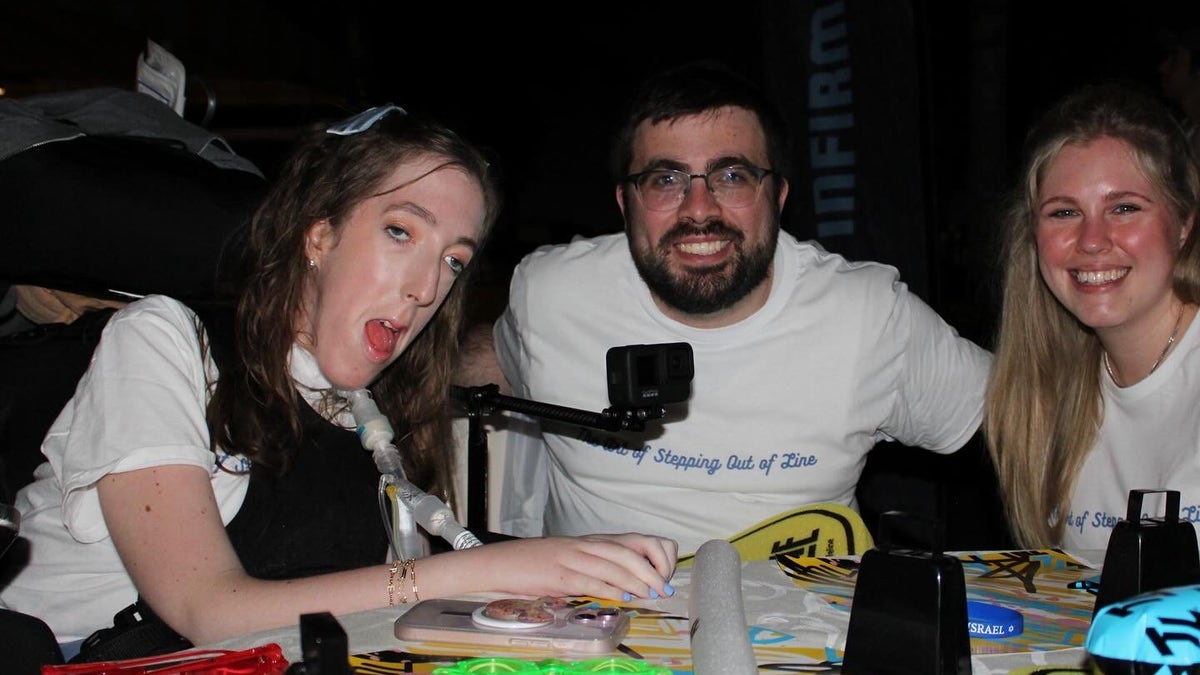
Finkelstein is pictured with her siblings, Katy Finkelstein (right) and Joel Finkelstein, in January 2024. She credits her family with supporting her through all her endeavors. (Barbara Quagliard)
Life itself can be compared to the dozen marathons she has competed in, according to Finkelstein.
“You have to push yourself to the limit for each mile marker, as nothing will ever come easily,” she said.
“All the pain, traumas and setbacks are what enable you to keep going and keep hustling.”
“You have to power through the pain, because there is no other option.”
Future goals
Since hitting the $1 million milestone, Finkelstein and her foundation have launched new projects, including a scholarship fund in partnership with Adelphi University, where she earned her MBA in marketing.
CLICK HERE TO SIGN UP FOR OUR HEALTH NEWSLETTER
She also works to boost awareness and education through speaking engagements, social media and podcasting, and hosts various fundraising events throughout the year.
Finkelstein plans to write and publish a memoir to share her life’s journey with the world.
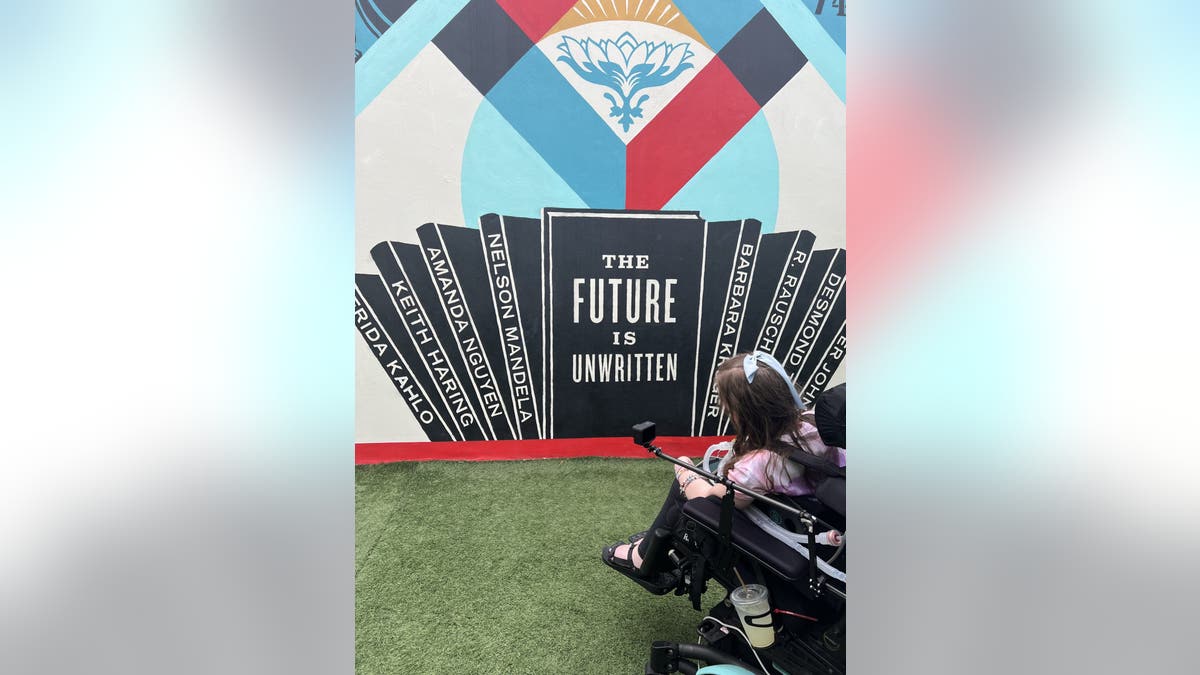
“It’s always in the back of my mind that I cannot wait to live my life — because of physical disability and medical challenges, it could be cut short,” Finkelstein said. (Team Peri Foundation)
“While I used to be an athlete, I am still just as competitive and am somewhat of an overachiever in the real world,” Finkelstein said.
The entrepreneur is also acutely aware that life is short.
For more Health articles, visit www.foxnews.com/health
“It’s always in the back of my mind that I cannot wait to live my life — because of physical disability and medical challenges, it could be cut short,” she said.
“My time is precious, and I still have a lot more to accomplish.”
Health
Down Syndrome Awareness Month: 5 key questions answered
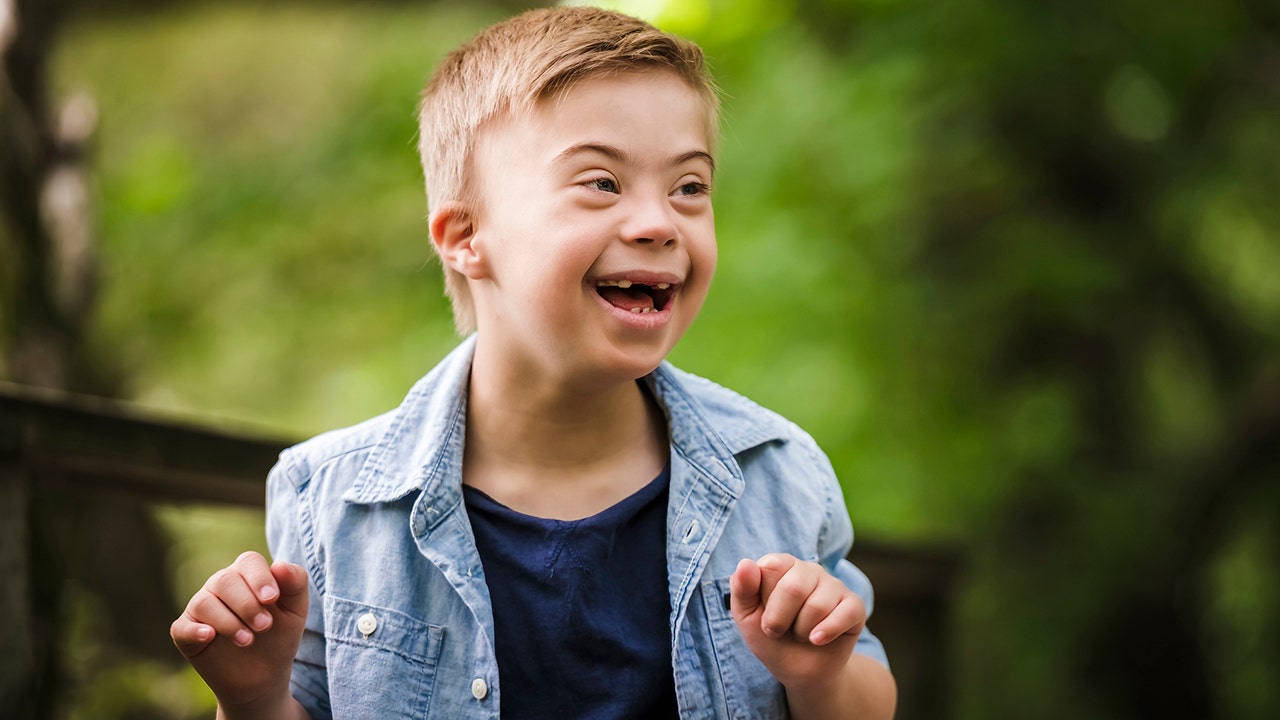
As October marks World Down Syndrome Awareness Month, it’s an opportune time to learn and support those with the condition.
About 5,700 babies are born in the U.S. with Down syndrome each year, and more than 400,000 people in the country currently live with it, according to the Centers for Disease Control and Prevention (CDC).
The life expectancy of those with the condition has increased dramatically over the years. In 1983, it was just 25 years old, but it is now 60, per the Global Down Syndrome Foundation.
LIFELONG BEST FRIENDS WITH DOWN SYNDROME TO ATTEND COLLEGE TOGETHER
Below is everything you need to know about Down syndrome and how you can help spread awareness about it.
Read on …
October is Down Syndrome Awareness Month around the world. About 5,700 babies are born in the U.S. with Down syndrome each year. (iStock)
- What is Down syndrome?
- What are the symptoms of Down syndrome?
- Why is National Down Syndrome Awareness Month important?
- What ribbon represents Down syndrome?
- How do you observe Down Syndrome Awareness Month?
1. What is Down syndrome?
Down syndrome is a condition in which a baby is born with an extra chromosome.
Chromosomes determine how the body forms and functions. Those born with an extra chromosome experience changes in the way the body and brain develop.
A baby is typically born with 46 chromosomes. A baby with Down syndrome has a full or partial copy of chromosome 21.
The most common type of Down syndrome is trisomy 21, which accounts for 95% of all cases.
Less common types of Down syndrome are translocation (caused by rearranged chromosome material) and mosaicism (when there is a mixture of two types of cells).
There are no known ways to prevent the condition during pregnancy and no known root causes, experts say.
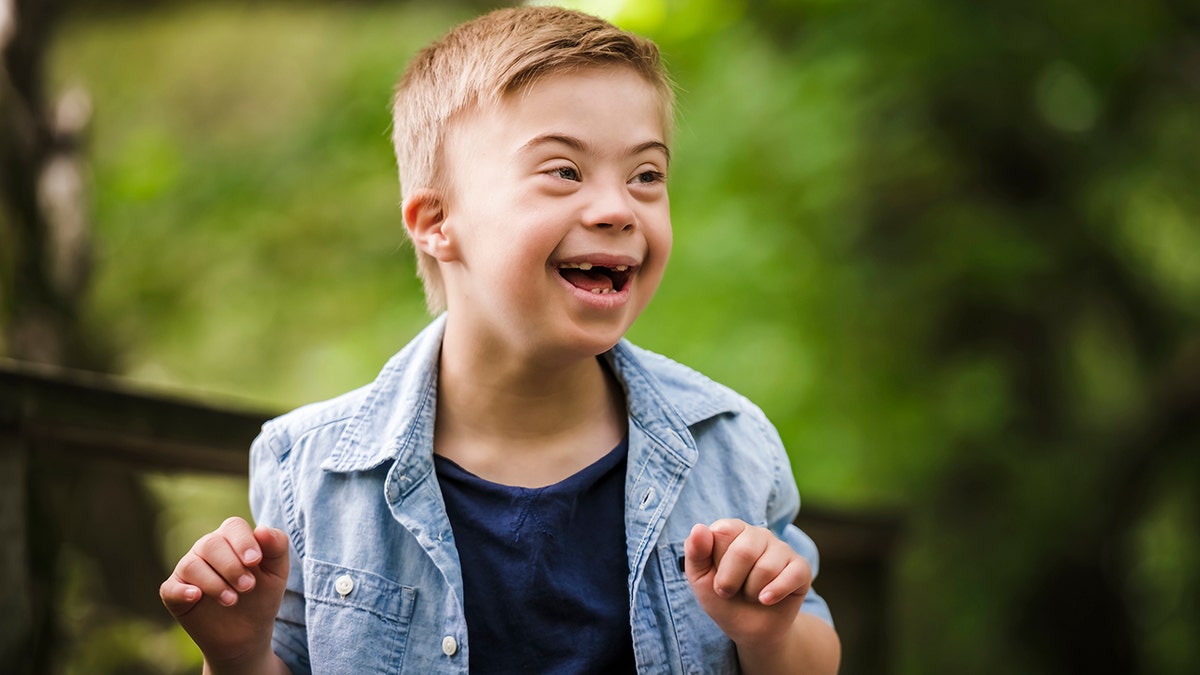
Down syndrome is a condition in which a baby is born with an extra chromosome. The most common type of Down syndrome is trisomy 21, which accounts for 95% of all cases. (iStock)
One risk factor associated with Down syndrome is the age of the mother — for a 25-year-old pregnant woman, the odds are about 1 in 1,250. At age 40, they are 1 in 100, statistics show.
2. What are the symptoms of Down syndrome?
There are both physical and developmental symptoms of Down syndrome.
NANNY AND 5-YEAR-OLD WITH DOWN SYNDROME SAY DAILY AFFIRMATIONS TOGETHER-‘SO EMOTIONAL’
Physical symptoms include a flattened face; shorter height; short neck; small ears, hands and feet; and decreased muscle tone, according to the CDC.

Physical symptoms include a flattened face; shorter height; short neck; small ears, hands and feet; and decreased muscle tone, according to the CDC. (BSIP/Universal Images Group via Getty Images)
Developmental symptoms include a short attention span, impulsive behavior, slow learning and delayed speech development.
While these are all common symptoms, not every child with Down syndrome will display each one of these traits.
3. Why is National Down Syndrome Awareness Month important?
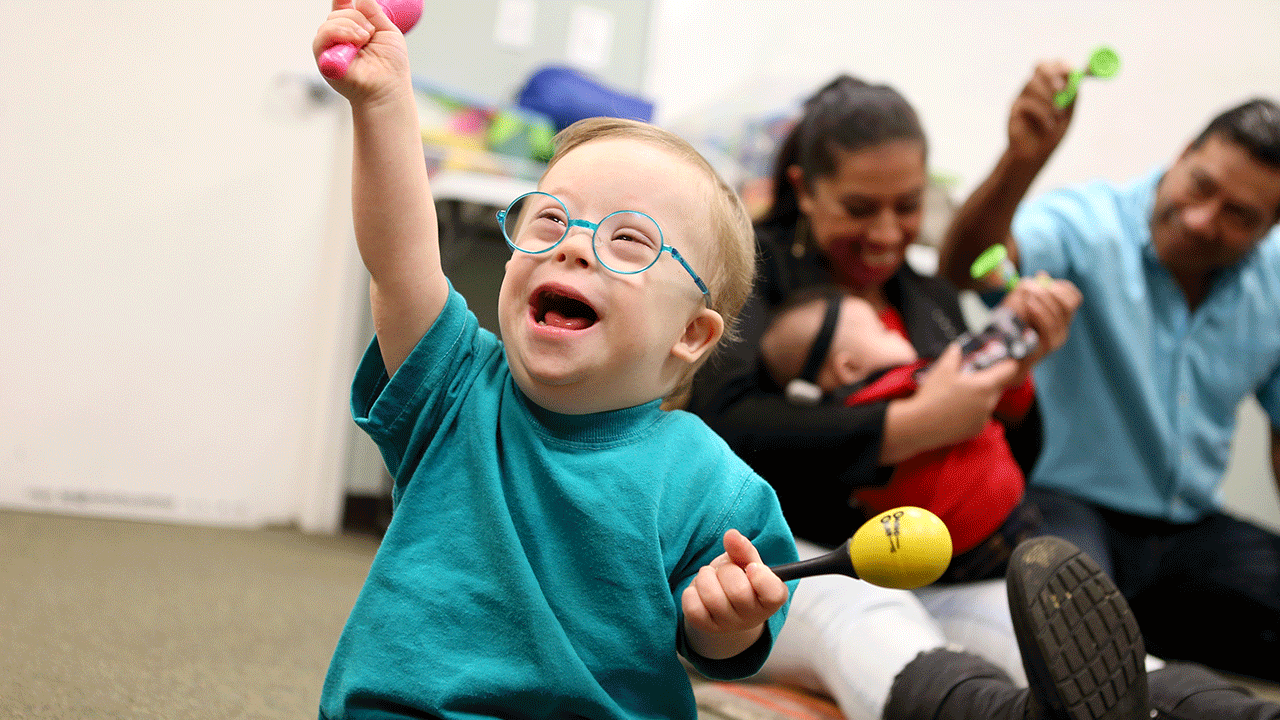
National Down Syndrome Awareness Month promotes education about the condition. (Anda Chu/Digital First Media/The Mercury News via Getty Images)
National Down Syndrome Awareness Month is “a month to raise awareness and celebrate the many abilities of our loved ones with Down syndrome,” according to the National Down Syndrome Society, which created the occasion in the 1980s.
“Down syndrome is one of the most common types of intellectual disabilities,” states the Special Olympics website.
“Down syndrome is one of the most common types of intellectual disabilities.”
“So, it’s no surprise that each year in October, we recognize Down Syndrome Awareness Month to raise public awareness about the condition and advocate for acceptance and inclusion of people with Down syndrome.”
CLICK HERE TO SIGN UP FOR OUR HEALTH NEWSLETTER
“People with Down syndrome still face stereotypes and myths, but they’ve shown time and again that the condition is just one part of who they are and doesn’t define them or limit their abilities,” the statement continued.
“That’s why it’s so important that during Down Syndrome Awareness Month and all year long, we help spread the message of love, acceptance, inclusion and respect.”
4. What ribbon represents Down syndrome?
The Down syndrome awareness ribbon is blue and yellow. People can choose to wear a blue and yellow ribbon throughout the month to spread awareness.
Some also choose days to wear blue and yellow clothing to spread the word and support those with Down syndrome throughout the month.

The Down syndrome awareness ribbon is blue and yellow. (iStock)
World Down Syndrome Day is celebrated on March 21 each year – which stands for the tripling of the 21st chromosome (3.21) in people with the condition.
5. What can you do to observe Down Syndrome Awareness Month?
Educating yourself and others about Down syndrome is one way to honor the occasion throughout the month. You can educate yourself by reading books and articles and watching documentaries.
For more Health articles, visit foxnews.com/health
You can take your knowledge and spread awareness to others by sharing information on social media.
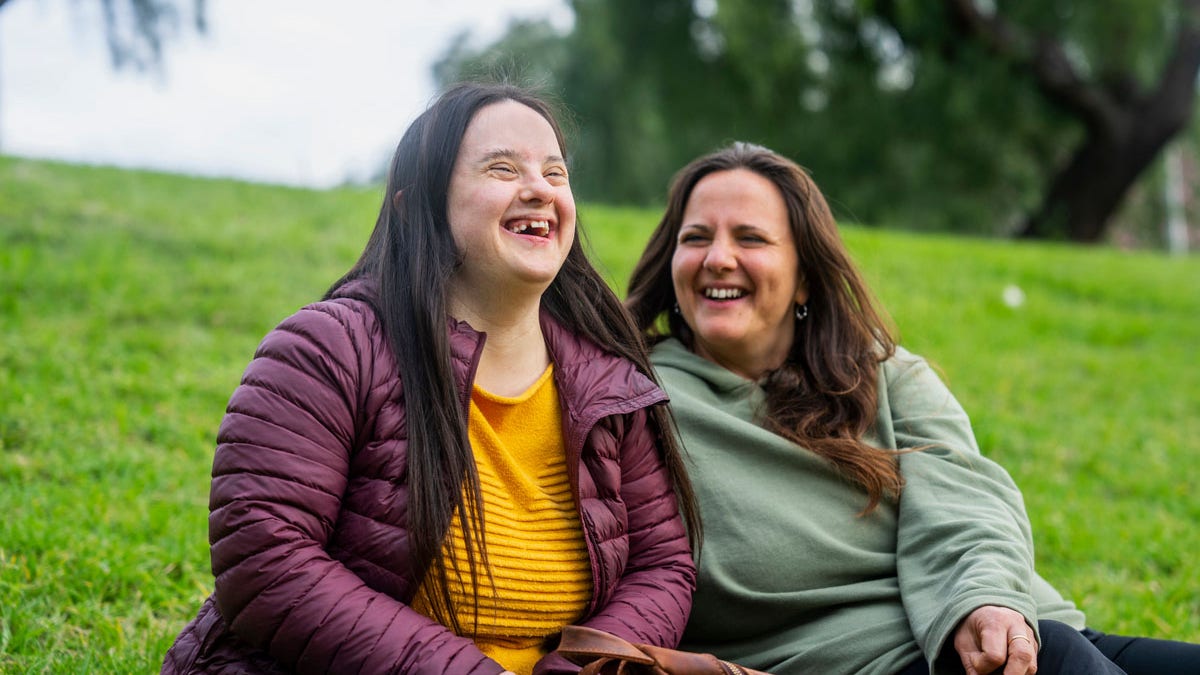
World Down Syndrome Day is celebrated on March 21 each year – which stands for the tripling of the 21st chromosome (3.21) in people with the condition. (iStock)
Through the month of October, there are plenty of events, fundraisers and walks around the country dedicated to Down syndrome awareness.
You can also choose to set up a fundraiser of your own or support a local business founded by or inspired by individuals with Down syndrome.
There are also many volunteer opportunities to take advantage of during this time. GiGi’s Playhouse and Special Olympics are two examples of organizations that participate.
Health
Enter Our Weight Loss Dyson Sweepstakes and Survey | Woman's World

Sign Up
Create a free account to access exclusive content, play games, solve puzzles, test your pop-culture knowledge and receive special offers.
Already have an account? Login
Use left and right arrow keys to navigate between menu items.
Use escape to exit the menu.
-
/cdn.vox-cdn.com/uploads/chorus_asset/file/25439572/VRG_TEC_Textless.jpg)
/cdn.vox-cdn.com/uploads/chorus_asset/file/25439572/VRG_TEC_Textless.jpg) Technology6 days ago
Technology6 days agoCharter will offer Peacock for free with some cable subscriptions next year
-

 World5 days ago
World5 days agoUkrainian stronghold Vuhledar falls to Russian offensive after two years of bombardment
-

 World6 days ago
World6 days agoWikiLeaks’ Julian Assange says he pleaded ‘guilty to journalism’ in order to be freed
-

 Technology5 days ago
Technology5 days agoBeware of fraudsters posing as government officials trying to steal your cash
-

 Health4 days ago
Health4 days agoHealth, happiness and helping others are vital parts of free and responsible society, Founding Fathers taught
-

 Virginia1 week ago
Virginia1 week agoStatus for Daniels and Green still uncertain for this week against Virginia Tech; Reuben done for season
-

 Sports4 days ago
Sports4 days agoFreddie Freeman says his ankle sprain is worst injury he's ever tried to play through
-

 News4 days ago
News4 days agoLebanon says 50 medics killed in past three days as Israel extends its bombardment














